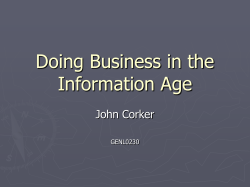
Technology Acceptance Model (TAM) Damian Gordon
Technology Acceptance Model (TAM) Damian Gordon 1989 Technology Acceptance Model The Technology Acceptance Model (TAM) is an information systems theory that models how users come to accept a technology and how they use that technology. Developed by Fred Davis in 1989 Fred Davis Fred D. Davis’s 1989 articles in MIS Quarterly and Management Science are the most highly cited articles in those journals. Davis is listed in ISI HighlyCited.com, which features “the world's most influential researchers”. 1989 Technology Acceptance Model Perceived Usefulness Intention to Use Perceived Ease of Use Usage Behaviour First, a bit of history... 1975 Acceptance Models Theory of Reasoned Action (TRA) developed by Martin Fishbein and Icek Ajzen 1975 Acceptance Models Theory of Reasoned Action (TRA) TRA suggests that a person's behavioural intention depends on the person's attitude about the behaviour (“Would I do this sort of thing normally?”) and subjective norms (“Would other people in the group do this?”). 1975 Theory of Reasoned Action Attitude Towards Behaviour Behavioural Intention Subjective Norm Behaviour 1985 Acceptance Models Theory of Planned Behaviour (TPB) developed by Icek Ajzen 1985 Acceptance Models Theory of Planned Behaviour (TPB) Extension of his Theory of Reasoned Action (TRA), since TRA states that actual behaviour is highly related to behavioural intention, but the results of some studies show that, because of circumstantial limitations, behavioural intention does not always lead to actual behaviour. 1985 Acceptance Models Theory of Planned Behaviour (TPB) TPB adds the notion of Perceived behavioural control which refers to a person’s perceptions of their ability to perform a given behaviour. 1985 Theory of Planned Behaviour Attitude Towards Behaviour Subjective Norm Perceived Behavioural Control Behavioural Intention Behaviour 1995 Acceptance Models Decomposed Theory of Planned Behaviour (DTPB) developed by Taylor and Todd Like the TPB but decomposes the attitudinal, normative and control beliefs into multidimensional constructs, which provides more explanatory power, better diagnostic value and strengthens the ability of the model to explain behavioural intention. 1995 Decomposed Theory of Planned Behaviour Ease-of-Use Perceived Usefulness Compatibility Attitude Towards Behaviour Peer Influence Superior’s Influence Subjective Norm Self-efficacy Resource facilitating condition Technology facilitating condition Perceived Behavioural Control Behavioural Intention Behaviour Other Models Diffusion of Innovations Theory (DIT) Innovation Diffusion Theory (IDT) The Social Cognitive Theory (SCT) The Motivational Model (MM) The Model of PC Utilisation (MPCU) Unified Theory of Acceptance and Use of Technology (UTAUT) Matching Person & Technology (MPT) So onto the Technology Acceptance Model (TAM) 1989 Technology Acceptance Model When users are presented with a new technology, two key factors influence their decision about how and when they will use it: – Perceived usefulness (PU) - the degree to which a person believes that using a particular system would enhance his or her job performance. – Perceived ease-of-use (PEOU) - the degree to which a person believes that using a particular system would be free from effort. 1989 Technology Acceptance Model Perceived Usefulness Intention to Use Perceived Ease of Use Usage Behaviour 1989 Technology Acceptance Model 1989 Technology Acceptance Model
© Copyright 2025














